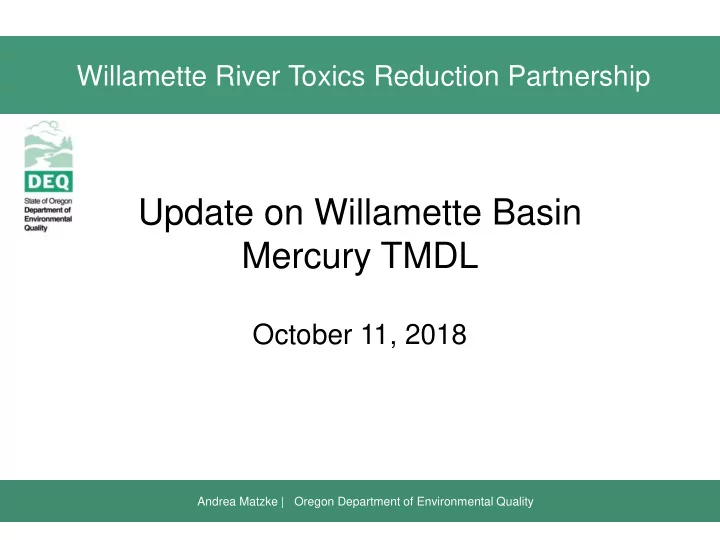

Willamette River Toxics Reduction Partnership Update on Willamette Basin Mercury TMDL October 11, 2018 Andrea Matzke | Oregon Department of Environmental Quality
Overview of TMDL Process ▪ Identify water quality concerns ▪ Identify sources and conditions contributing to concerns ▪ Link sources and conditions to water body ▪ Calculate load reductions to restore water quality
Mercury TMDL Team ▪ Advisory Committee: Seven meetings to date ▪ EPA and DEQ team with contractor support ▪ DEQ team: – Paula Calvert (Project Manager) – Priscilla Woolverton – Andrea Matzke – Kevin Brannan
Mercury Standards to Meet Develop TMDL to meet WQ standards for protection of human health and aquatic life ➢ fish/shellfish criterion (2011) = 0.040 mg/kg Allows safe consumption of up to 23 – 8oz meals/month ➢ water column chronic criterion = 0.012 ug/L
Mercury Water Quality Impairments Across Basin
Technical Approach Objective: Link sources of total Hg to meHg in fish ▪ meHg is bioaccumulative ▪ Potent neurotoxin: Primary human risk is from consuming fish/shellfish with high levels of meHg.
Technical Approach Three Components: ▪ Mass Balance Model ➢ Link Hg sources in watershed to water concentrations — both point sources and nonpoint sources ▪ Mercury Translator ➢ Link total Hg to meHg ▪ Food Web Model ➢ Links Hg in environment to Hg contamination in fish
Draft Results Courtesy of Tetra Tech Note: A majority of the sediment and groundwater loads ultimately originate from historic atmospheric deposition of mercury.
Draft Modeling Results ▪ To meet tissue criterion, instream total Hg water target = 0.14 ng/L (0.00014 ug/L) ➢ based on northern pike minnow BMF (conservative assumption) ▪ Draft results indicate large % total Hg reductions needed to meet instream water target (calculated for 12 8-digit HUCs)
Management Measures ▪ Majority of Hg originating from air deposition to land surfaces ▪ “Controllable” Strategies: • NPS — reduce erosion to streams • PS — variances, mercury minimization plans ▪ Designated Management Agencies: ODA, ODF, ODOT, cities, counties, BLM, USFS, ACOE, etc. ▪ Water Quality Management Plan not yet completed
Wrap Up ▪ Litigation deadline: April 2019 ➢ EPA and DEQ request for extension ▪ Public Comment: Winter ▪ For more information: https://www.oregon.gov/deq/wq/tmdls/Pages /willhgtmdlac2018.aspx
Story Map Discussion What key partners, activities, and efforts are missing? http://bit.ly/WWTRPStoryMap
Where Are We Going? Partnership Principles: ▪ to compile existing watershed contamination data and identify data gaps; ▪ to describe existing efforts, and evaluate the efficacy of these programs; ▪ to investigate potential upstream sources of contamination to the Portland Harbor Superfund site, considering any data gaps identified; and ▪ to identify new strategies to reduce contaminant loading.
Recommend
More recommend